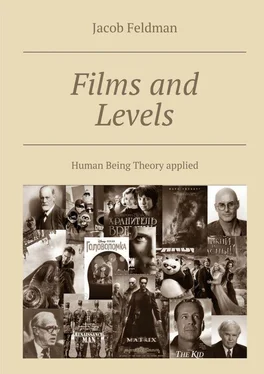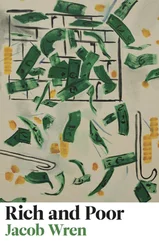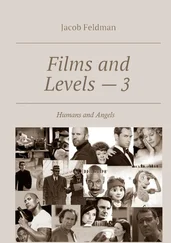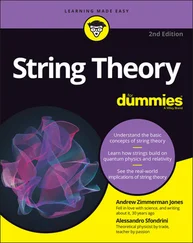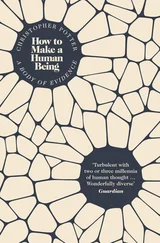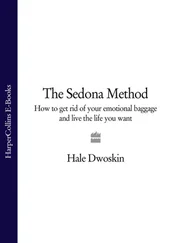Films and Levels
Human Being Theory applied
Jacob Feldman
© Jacob Feldman, 2017
ISBN 978-5-4483-4906-5
Created with intellectual publishing system Ridero
Storytelling versus problem solving
This book, named Films and Levels ( FLS), is a sequel after my previous book, named «[битая ссылка] Human Being Theory (for Dummies)” ( HBT)
HBTcontains many ideas and a few examples.
FLScontains many examples and retells briefly relevant pieces of HBT.
It is easy to describe a problem briefly after it is formalized. But it is impossible to describe it briefly before good formalizing.
So what?
I have found a tricky solution. I use films as a raw material. I use only modern popular films. They are easy to find. Watching the film usually takes less time than reading the book with the same plot.
While watching the film in a theater you cannot stop the moment, but when you watch it at home with computer, you can. You can watch it at home as many times as you need. When discussing such films I could be sure that we both discuss the same raw material.
What is a film? It is a message from authors to a viewer. Suppose you are the viewer. Did you understand the message completely? Did you understand it correct?
Some part of the message targets to your subconscious , other – to your consciousness . Would you like to open all information of the message to your consciousness ?
If yes, this book could help you. Some people just enjoy films. Other want to understand the message.
To understand is the key.
Imagine broadcasting. To catch certain broadcast the receiver must be tuned to a specific frequency. The same thing happens in human communication.
My idea is that there are only eight allowed frequencies for human communication. I call them levels .
For the first time these levels were described by Clare W. Graves in the middle of XX century. He called them levels of existence . Graves died in 1986. In 1989 me, Jacob Feldman, though never knew about Graves and his levels of existence, described the same levels as levels of attention or levels of abstract intelligence .
Levels of Graves and levels of Feldman work in different models and it makes their meanings different. But they describe the same reality. From this moment, levels are levels by Feldman.
In 1996, Don Beck and Christopher Cowan published a book called Spiral Dynamics: Mastering Values, Leadership, and Change (Exploring the New Science of Memetics) . In this book, Graves’ model was retold briefly. And new strange scale of colors was added to the model.
After this book was published, Wilber (holder of Integral Approach brand) got acquainted to the model, appreciated it and included it into his own Pantheon of Models about Human .
If you want to know in a few words what is the difference between Levels-by-Feldman and Levels-byGraves-Beck-Wilber, the answer is as follows.
(1) There are eight levels of attention.
(2) For every level, there are tasks with the certain structure.
(3) Every task has its best level
(4) Every adult person has four favorite levels; they are immutable and form his/her profile.
(5) Nobody never changes his/her profile by plan, wish, or work. Sometimes people change their profiles after personal disaster.
(6) There are strong conclusions about age-of-child and epoch-of-history
(1) No new ideas about attention.
(2) Nothing about tasks.
(3) An axiom: higher level is better for every task.
(4) An axiom: every person or group has one and only one current level.
(5) An axiom: to change the level you need to good your own work in good envirenment. Hire couch to get it!
(6) No clear suggestions about age-of-child and epoch-of-history
For every film in the book, we will try things as follows.
First , we define levels of broadcasting of the message (from author to viewer).
Second , we analyze characters of the film; we define their levels of communication, thinking, and acting.
Third , we analyze features of characters beyond levels, like warming-up curves. It refers to the personality model described in the HBT book. If you did not read the book, you can find basic definitions here.
Levels: Model and Interpretation
Imagine a person. Imagine a list of eight states-of-mind = levels – from 1 to 8. Imagine that the person in every moment is in one specific state-of-mind from the list (= on specific level).
Every level has specific field of attention , which in turn determines specific worldview, specific set of features of thinking and behavior etc. Every field of attention can hold some specific structure.
Complexity of the structure depends on number of level. The structures are as follows:
(1) One object
(2) Many object
(3) One process
(4) Many processes
(5) One map
(6) Many maps
(7) One system
(8) Many systems
If you never have seen the list before don’t give up. Just write in in a piece of paper, hang over your working place and try to memorize it as a poem .
For every level, we will see an episode or episodes where the level demonstrates itself clear. Read the book and understand the model and how to see it in real life.
I will use phrases
person #X
or
attention #X
instead of
person on level #X.
Now we will focus on level 4 and level 3.
Level 4 holds in attention many processes. Person #4 sees the world as a role system where he has his own role. To save the world everybody must play his/her own role , follow the rules , do the job, duties , obligations and keep promises . Good guys follow the rules, bad guys do not.
Role, rules, duties, obligations, promises are keywords of the level #4.
Sometimes level #4 uses the word mission . But mission is wider than that; it includes some ideas or values – these words belong to higher levels (6, 7, 8)
The key conflict of the story is between the company, which operates the oil rig ( Transocean Ltd in our case), and the company that pays ( British Petroleum or BP in our case).
We see first sign of the conflict when Jimmy Harrell, captain of the rig (starring Kurt Russell) learns that PB ordered to geologists omit the procedure of ground checking around the rig. This order breaks the rules!
But the work at the rig is behind of schedule by 43 days and BP-specialists break rules to speed it up. Now some more theory
According the model, attention #3 holds one process. It means that the person sees the world as a directed line , with the target at the endpoint. Time is the measure of how close we are to the target. Thing helping to get the target are important. Other things are ignored including all kinds of rules.
Читать дальше
